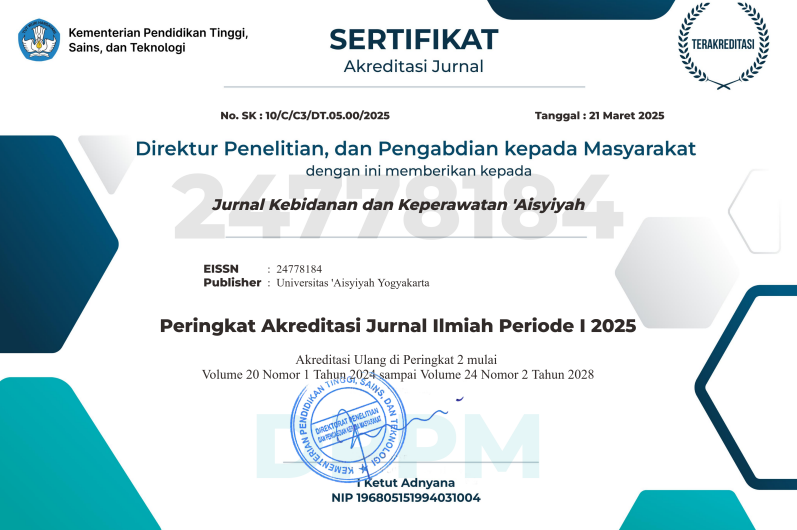Status gizi ibu berkontribusi terhadap kejadian BBLR
DOI:
https://doi.org/10.31101/jkk.1144Abstract views 1345 times
Keywords:
BBLR, ibu hamil, status giziAbstract
Downloads
References
Agorinya, I. A., Kanmiki, E. W., Nonterah, E. A., Tediosi, F., Akazili, J., Welaga, P., Azongo, D., & Oduro, A. R. (2018). Socio-demographic determinants of low birth weight: Evidence from the Kassena-Nankana districts of the Upper East Region of Ghana. Plos One, 13(11). https://doi.org/10.1371/journal.pone.0206207
Amegah, A. K., Quansah, R., & Jaakkola, J. J. K. (2014). Household air pollution from solid fuel use and risk of adverse pregnancy outcomes: A systematic review and meta-analysis of the empirical evidence. Plos One, 9(12). https://doi.org/10.1371/journal.pone.0113920
Anggraini, D. P., Aditiawarman, Utomo, B., & Suryawan, A. (2014). Risk factors of low birth weight (LBW) incidence: A case control study. Folia Medica Indonesiana, 50(4). http://journal.unair.ac.id/FMI@risk-factors-of-low-birth-weight-(lbw)-incidence.-a-case-control-study-article-9330-media-3-category-3.html
Ariyani, D. E., Achadi, E. L., & Irawati, A. (2012). Validitas lingkar lengan atas mendeteksi risiko kekurangan energi kronis pada wanita Indonesia. Kesmas: Jurnal Kesehatan Masyarakat Nasional (National Public Health Journal), 7(2), 83–90. https://doi.org/10.21109/kesmas.v7i2.67
Azzizah, E. N., Faturahman, Y., & Novianti, S. (2021). Faktor-faktor yang berhubungan dengan kejadian bayi berat lahir rendah (studi di RSUD DR. Soekardjo Kota Tasikmalaya). Jurnal Kesehatan Komunitas Indonesia, 17(1), Article 1. https://doi.org/10.37058/jkki.v17i1.3606
Blencowe, H., Krasevec, J., de Onis, M., Black, R. E., An, X., Stevens, G. A., Borghi, E., Hayashi, C., Estevez, D., Cegolon, L., Shiekh, S., Ponce Hardy, V., Lawn, J. E., & Cousens, S. (2019). National, regional, and worldwide estimates of low birthweight in 2015, with trends from 2000: A systematic analysis. The Lancet Global Health, 7(7), e849–e860. https://doi.org/10.1016/S2214-109X(18)30565-5
Demelash, H., Motbainor, A., Nigatu, D., Gashaw, K., & Melese, A. (2015). Risk factors for low birth weight in Bale zone hospitals, South-East Ethiopia: A case–control study. BMC Pregnancy and Childbirth, 15(1), 264. https://doi.org/10.1186/s12884-015-0677-y
Deriba, B. S., & Jemal, K. (2021). Determinants of low birth weight among women who gave birth at Public Health Facilities in North Shewa Zone: Unmatched case-control study. INQUIRY: The Journal of Health Care Organization, Provision, and Financing, 58, 00469580211047199. https://doi.org/10.1177/00469580211047199
Fajriana, A., & Buanasita, A. (2018). Faktor risiko yang berhubungan dengan kejadian bayi berat lahir rendah di Kecamatan Semampir Surabaya. Media Gizi Indonesia, 13(1), 71–80. https://doi.org/10.20473/mgi.v13i1.71-80
Gill, S. V., May-Benson, T. A., Teasdale, A., & Munsell, E. G. (2013). Birth and developmental correlates of birth weight in a sample of children with potential sensory processing disorder. BMC Pediatrics, 13(1), 29. https://doi.org/10.1186/1471-2431-13-29
Istyati, S., & Wijhati, E. R. (2022). Analisis kejadian BLLR Di RS PKU Muhammadiyah Kota Yogyakarta. Jurnal Kebidanan dan Keperawatan Aisyiyah, 18(1), Article 1. https://doi.org/10.31101/jkk.2480
Jayanti, F. A., Dharmawan, Y., & Aruben, R. (2017). Faktor-faktor yang berhubungan dengan kejadian berat badan lahir rendah di wilayah kerja Puskesmas Bangetayu Kota Semarang tahun 2016. Jurnal Kesehatan Masyarakat (Undip), 5(4), 812–822.
Kementerian Kesehatan RI. (2013). Riset Kesehatan Dasar (Riskesdas) 2013. Lembaga Penerbit Balitbangkes, Kementerian Kesehatan, Republik Indonesia, Badan Penelitian dan Pengembangan Kesehatan.
Kementerian Kesehatan RI. (2019). Laporan nasional Riskesdas 2018. Lembaga Penerbit Balitbangkes, Kementerian Kesehatan, Republik Indonesia, Badan Penelitian dan Pengembangan Kesehatan.
Kementerian Kesehatan RI. (2021). Profil Kesehatan Indonesia Tahun 2020. Kementerian Kesehatan Republik Indonesia.
Maghfiroh, L. (2015). Pertambahan berat badan ibu hamil dan kejadian berat bayi lahir rendah (BBLR) di wilayah kerja Puskesmas Pamulang Tahun 2013-2015. https://repository.uinjkt.ac.id/dspace/handle/123456789/36984
Nurhayati, E., & Fikawati, S. (2016). Indeks massa tubuh (IMT) pra hamil dan kenaikan berat badan ibu selama hamil berhubungan dengan berat badan bayi lahir. JNKI (Jurnal Ners dan Kebidanan Indonesia) (Indonesian Journal of Nursing and Midwifery), 4(1), 1–5. https://doi.org/10.21927/jnki.2016.4(1).1-5
Pritasari, Damayanti, D., & Lestari, N. T. (2017). Gizi dalam daur kehidupan. Kementerian Kesehatan Republik Indonesia.
Purwanto, A. D., & Wahyuni, C. U. (2016). Hubungan antara umur kehamilan , kehamilan ganda, hipertensi dan anemia dengan kejadian bayi berat lahir rendah (BBLR). Jurnal Berkala Epidemiologi, 4(3), 349–359. https://doi.org/10.20473/jbe.v4i3. 2016. 349–359
Rini, S. S., & W, I. T. (2015). Faktor – faktor risiko kejadian berat bayi lahir rendah di wilayah kerja Unit Pelayanan Terpadu Kesmas Gianyar II. E-Jurnal Medika Udayana. https://ojs.unud.ac.id/index.php/eum/article/view/13057
Safitri, H. O., Fauziningtyas, R., Indarwati, R., Efendi, F., & McKenna, L. (2022). Determinant factors of low birth weight in Indonesia: Findings from the 2017 Indonesian demographic and health survey. Journal of Pediatric Nursing, 63, e102–e106. https://doi.org/10.1016/j.pedn.2021.10.005
Sumiaty, & Restu, S. (2016). Kurang energi kronis (KEK) ibu hamil dengan bayi berat lahir rendah (BBLR). Jurnal Husada Mahakam, 4(3), 162–170.
Sutan, R., Mohtar, M., Mahat, A. N., & Tamil, A. M. (2014). Determinant of low birth weight infants: A matched case control study. Open Journal of Preventive Medicine, 04(03), 91–99. https://doi.org/10.4236/ojpm.2014.43013
WHO. (2014). Global nutrition targets 2025: Low birth weight policy brief (WHO/NMH/NHD/14.5 (p. 8). World Health Organization.
World Health Organization. (2022, January 28). Newborn mortality. Fact Sheets. https://www.who.int/news-room/fact-sheets/detail/levels-and-trends-in-child-mortality-report-2021
Downloads
Additional Files
Published
How to Cite
Issue
Section
License
With the receipt of the article by the Jurnal Kebidanan dan Keperawatan Aisyiyah Editorial Board and the decision to be published, then the copyright regarding the article will be diverted to Jurnal Kebidanan dan Keperawatan Aisyiyah. Universitas 'Aisyiyah Yogyakarta as the publisher of Jurnal Kebidanan dan Keperawatan Aisyiyah hold the copyright regarding all the published articles in this journal.
Jurnal Kebidanan dan Keperawatan Aisyiyah is licensed under a Creative Commons Attribution-ShareAlike 4.0 International License.
















